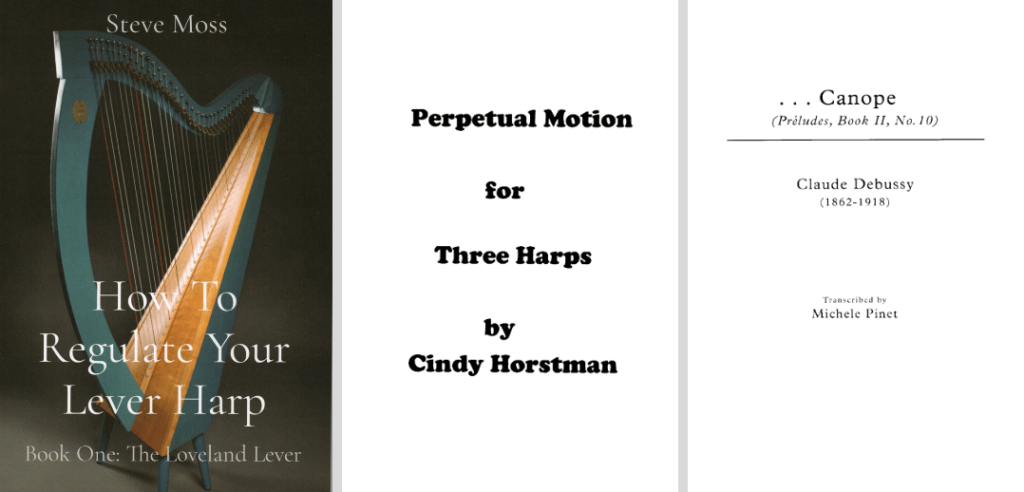
Steve Moss has written and self-published a handy little manual through his publishing venture, Northside Press. How to Regulate Your Lever Harp is subtitled “Book One: The Loveland Lever,” indicating there will be more volumes to come focusing on other types of levers. Several different harp manufacturers used Loveland levers for many years, so there are a lot of harps out there with this style lever.
As Moss points out in the preface, it can be difficult to find a technician to do service and repairs. You may not want to regulate your own lever harp, but having this book in your library could be a godsend in the event an emergency arises.
He begins by defining a regulation and why and how often harps need them. There are plenty of color photographs illustrating the parts of the harp as well as the Loveland levers. There are even photos of the tools you will need. All aspects of a regulation are explained including general maintenance, strings, tuning pins, different types of buzzes, and intonation. The explanations are clear and relatively easy to understand, even for those not mechanically inclined.
There are also four appendices. Appendix A covers some basic theory, whole and half steps, enharmonic equivalents, and different keys. All this information could be daunting to someone new to music. It is, however, a useful introduction to music and beneficial to a non-harpist trying to understand the harp. There is an error on page 64 where the C sharp in the next to the last line should be an F sharp. There are several other typos throughout the book, but most of them do not affect the meaning and an errata sheet should be provided with each book.
Appendix B covers how to repair stripped screw holes. Appendix C shows you how to replace levers and cams, and Appendix D discusses the myth of perfect intonation. The book is currently available as a paperback through the author’s website, mossharpservice.com. An eBook edition is also available. If you own a harp with Loveland levers, this is worth adding to your library. If not, you may want to wait for one of the subsequent editions. Stay tuned!
Cindy Horstman has been a valuable resource for music for multiple harps. She has added an original tune to her growing assortment of self-published, jazzy harp ensemble music. “Perpetual Motion” is arranged for three harps and is dedicated to the Brookhaven College Harp Ensemble.
Whether by accident or design, it is sort of a multi-level piece. Harp 3 is the most challenging part, and as the name implies, it maintains a relentless, rhythmic bass pattern throughout the entire piece. Horstman describes the music as imitating “the persistence of a clock’s swinging pendulum,” and that is certainly true of Harp 3. There are several manageable pedal changes as the music alternates between C minor and C major. All pedal changes are marked below the staff.
Harp 2 is perhaps the easiest part to play, although it does require good counting skills. There are several tacet measures and it is often just the right hand playing or both hands in unison. This part could be played on lever harp, especially if you omitted the left hand playing in unison so you only had to move levers in one octave. However, there are no lever markings included.
Harp 1 is only slightly more difficult than Harp 2. In fact, these two parts play in unison through several sections. This would probably be the best part to adapt for lever harp if needed, as you would only have to move the E levers instead of E and A as in Harp 2.
This perpetual motion ends abruptly with a muffle on the first beat of the final measure. Fingering is suggested in a few places on Harp 1 and 2. It’s just a little over three minutes long and you can hear it on Horstman’s website at cindyhorstman.com.
The music comes with a score and three individual parts. You may purchase additional parts separately as needed. The typesetting is easy to read and page turns were well-planned to make them as manageable as possible. Intermediate players can probably sightread the music although some may find the rhythm a little challenging in spots.
“Perpetual Motion” is fun to play. If you’re planning some harp ensembles, you may want to consider this.
Advanced pedal harpists who are fans of Claude Debussy may be interested in a transcription by Michele Pinet. Debussy wrote two books of preludes for piano late in his life. These short pieces depicted a broad range of subjects. The titles were significant not only for describing the composition, but because they were also placed at the end of each piece. Debussy wanted the performer to experience the music without being influenced by the title. Lyon & Healy Publications has printed Pinet’s transcription of one of these preludes, “…Canope,” from Book 2, No. 10.
It is just three pages, and Pinet has done an admirable job of making it adaptable for harp. There are lots of pedal changes, including cross-pedaling, and they are clearly marked below the staff. A pedal chart is provided about halfway through the piece. It almost seems like a reward if you’ve made it that far with the correct pedals! Fingering is included. The music is beautiful—from mournful in some sections to almost lighthearted in others. You can listen to many samples on piano on YouTube. It’s worth the effort to learn and maybe it will pique your curiosity as it did mine: why did Debussy use the ellipsis in the title? •







